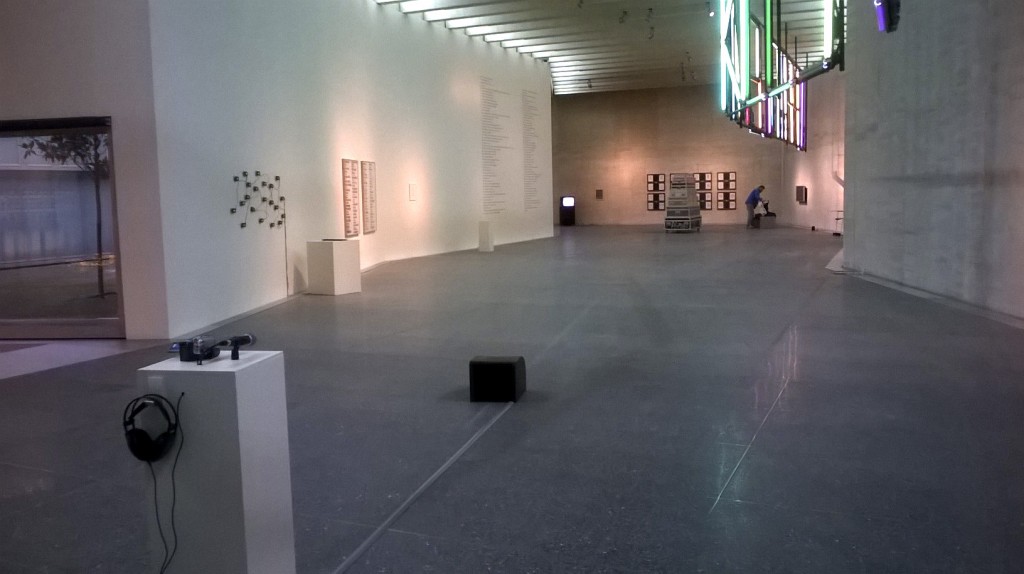How To Do Art With Words

Conceptual practices are at the root of much of contemporary art. Since their inception in the 60s, an interest in prioritising concept over form or technical expertise has led many artists to delve into these practices and to expand them to the present day. Today there is a growing interest in them which is visible both in the work of new generations of artists and in the publications and programmes of museums and art centres. These practices currently tend to be called post-conceptual because they present some differences with the conceptual art of the 60s of the last century. It is therefore appropriate to examine its present reality within MUSAC’s collection through the exhibition Cómo hacer arte con palabras, whose title is inspired by the well-known talk of the same name How to do Art with Words given by John Langshaw Austin in 1955.
As a result of conceptual practices’ prioritisation of the idea or the concept over the form, the image or the materialization of the work, it is the processual, the immaterial, the ephemeral or the interactive aspects that determine that we find performance as a live practice, recording and documentation media such as photography and video, or the use of different linguistic strategies —both in its dimension as sound and as a sign— at the basis of conceptual and post-conceptual art.
Words, texts, sentences, messages, dialogues, enunciations, proclamations and manifestos have been a widely used resource in contemporary projects and productions, often characterised by a non-conforming attitude vis-à-vis the status quo and by a will to transform the artistic and social establishments. Indeed, many of them try to integrate artistic activity in the wider context of sociopolitical, ecological and intellectual concerns. That is the reason why, initially, a large part of conceptual practices were against the production of works aimed to operate for profit in the market.
The word is sound and it is also sign. From this dual perspective, the linguistic universe underlies numerous conceptual practices for many diverse reasons: because of its communicative dimension, because of its commitment to some contemporary problems, because of its role as a tool for social and political action, because of its poetic dimension and because of its role as a speculative tool. Although many of these practices are trying to expand the territory of art, paradoxically, they also represent a kind of folding over itself of art in their promotion of citationistic, appropriationist and tautological strategies. In one way or another, the use of word and text’s sound and/or sign dimension in art doesn’t seek so much to find the logical structures of language as to study the behavior of the users of a language. That is: the way we learn to speak and what is the use of language for us, because, in fact, the raison d’être of language is in its use. Since language creates world, as the theory of performativity asserts, this exhibition shows us the world that post-conceptual practices are generating.
The notion of “performativity”, which is so much in vogue today, refers to the ability of some words and expressions to become actions and transform reality. In 1955 John Langshaw Austin (1911-1960) gave a series of lectures at Harvard University in which he reflected upon a type of expressions that rather than describing or stating a situation seemed to constitute, in themselves, an action. In his first lecture, which was entitled How to do Things with Words and was published posthumously in 1962, he called such expressions “performative”. Austin noted that verbs like “swear”, “declare”, “bequeath” or “baptise” produce sentences that are, in themselves, already an action. An obvious and hackneyed example is the moment in which a judge says: “I declare you husband and wife”, when, by saying the words, marriage is constituted, changing reality and the personal status prior to this sentence both for society and for the intending spouses.
Seen from this perspective, writing is doing. In his famous 1968 text “Death of the Author”, Roland Barthes revisits Austin’s aforementioned concept of performativity in order to speculate about the act of writing. For him, writing is, above all, a means of doing, of producing different realities generated both by the writer (read artist or performer in this case) and by the reader (or viewer) who, through reading, gives meaning, creates and embodies in his/her present what has been written. By being read, the text becomes reality in the form of the experience of those who read it. It is in this way how a critical aspect that reveals a crucial feature of the performative is brought to life and can be understood: what words do is to produce a subjectivity, i.e. a specific way to be conscious, to understand the world and to transform it.
Mieke Bal has argued through her “travelling concepts” that performance (in the Anglo-Saxon sense of acting) and performativity (the notion that a word does what it says) should not be addressed separately. Both share a transformative power, an insistence that the subject is not previous to the speech and that art is not “declarative” but “provocative” —i.e., performative. Therefore, conceptual and post-conceptual practices compel us to wonder about the performative uses of words and concepts rather than about their strict meaning. Nowadays, when a number of utopian horizons seem to be disappearing, when it seems that we are not able to do anything, it is important to highlight the creative, emancipatory and transformative power of language. That is to say: the power of words to do things, to create reality, to create world.